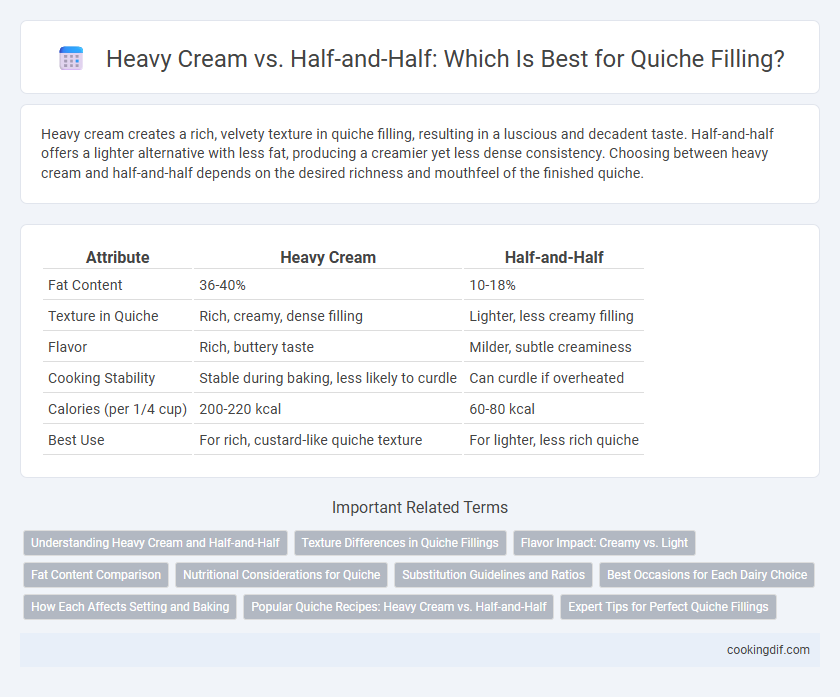Heavy cream creates a rich, velvety texture in quiche filling, resulting in a luscious and decadent taste. Half-and-half offers a lighter alternative with less fat, producing a creamier yet less dense consistency. Choosing between heavy cream and half-and-half depends on the desired richness and mouthfeel of the finished quiche.
Table of Comparison
| Attribute | Heavy Cream | Half-and-Half |
|---|---|---|
| Fat Content | 36-40% | 10-18% |
| Texture in Quiche | Rich, creamy, dense filling | Lighter, less creamy filling |
| Flavor | Rich, buttery taste | Milder, subtle creaminess |
| Cooking Stability | Stable during baking, less likely to curdle | Can curdle if overheated |
| Calories (per 1/4 cup) | 200-220 kcal | 60-80 kcal |
| Best Use | For rich, custard-like quiche texture | For lighter, less rich quiche |
Understanding Heavy Cream and Half-and-Half
Heavy cream contains around 36-40% milk fat, providing a rich and velvety texture essential for classic quiche fillings, while half-and-half has about 10-18% milk fat, resulting in a lighter consistency. The higher fat content in heavy cream enhances the custard's firmness and creaminess, creating a more indulgent quiche experience. Choosing half-and-half yields a less dense filling that's slightly less rich but can reduce overall calories and fat content in the quiche.
Texture Differences in Quiche Fillings
Heavy cream creates a richer, custard-like texture in quiche fillings due to its higher fat content, resulting in a smooth and velvety consistency. Half-and-half offers a lighter, less dense filling with a slightly firmer set, which can produce a more delicate quiche structure. Choosing between heavy cream and half-and-half directly impacts the quiche's mouthfeel and overall indulgence level.
Flavor Impact: Creamy vs. Light
Heavy cream imparts a rich, velvety texture and deep flavor to quiche filling, enhancing the overall creaminess and indulgence of each bite. Half-and-half offers a lighter, more subtle taste while maintaining smoothness, making it ideal for those seeking a less dense and lower-fat option. Choosing heavy cream intensifies the custard's richness, whereas half-and-half produces a delicate, balanced flavor with a milder mouthfeel.
Fat Content Comparison
Heavy cream typically contains 36-40% fat, providing a rich and silky texture to quiche filling, while half-and-half has a lower fat content, ranging from 10-18%, resulting in a lighter, less creamy consistency. The higher fat content in heavy cream contributes to a more luxurious mouthfeel and helps the filling set firmly during baking. Using half-and-half reduces overall calories and fat but may lead to a slightly less custardy quiche with a softer texture.
Nutritional Considerations for Quiche
Heavy cream in quiche filling provides a rich texture and higher fat content, typically around 36-40%, which contributes to a creamy consistency but also increases calorie and saturated fat levels. Half-and-half has approximately 10-12% fat, offering a lighter alternative that reduces overall calories and fat while maintaining moisture in the quiche. Choosing between heavy cream and half-and-half impacts nutritional values such as fat content, caloric density, and cholesterol, influencing the quiche's health profile.
Substitution Guidelines and Ratios
For quiche filling, using heavy cream instead of half-and-half results in a richer, creamier texture due to its higher fat content, typically about 36-40%. When substituting, use a 1:1 ratio, but expect a denser custard with heavy cream. Half-and-half, containing roughly 10-18% fat, offers a lighter texture while maintaining moisture, making it suitable for a less rich quiche without altering the liquid proportions.
Best Occasions for Each Dairy Choice
Heavy cream enriches quiche fillings with a rich, velvety texture ideal for special occasions like holiday brunches or elegant dinner parties where a luxurious mouthfeel is desired. Half-and-half offers a lighter alternative perfect for everyday meals or casual gatherings, providing a creamy taste with fewer calories. Choosing heavy cream intensifies flavor and moisture, making it suitable for quiches loaded with rich cheeses and meats, while half-and-half balances well with vegetable-centric or lighter fillings.
How Each Affects Setting and Baking
Heavy cream creates a richer, denser quiche filling that sets firmly due to its higher fat content, resulting in a smooth texture and a golden, slightly crisp top after baking. Half-and-half produces a lighter, less custardy filling with a softer set and quicker cooking time, often yielding a more delicate texture that may be slightly less stable when sliced. Choosing heavy cream enhances the quiche's structural integrity and luxurious mouthfeel, while half-and-half provides a lower-fat alternative that affects setting by producing a tender, less compact custard.
Popular Quiche Recipes: Heavy Cream vs. Half-and-Half
Popular quiche recipes often debate using heavy cream versus half-and-half for the filling, as heavy cream provides a richer, creamier texture with higher fat content, enhancing the custard's velvety consistency. Half-and-half offers a lighter alternative with fewer calories and less fat, resulting in a slightly less dense but still smooth filling. Choice between these dairy options depends on desired richness and caloric preference in the final quiche.
Expert Tips for Perfect Quiche Fillings
Heavy cream creates a richer, silkier quiche filling with a higher fat content that results in a tender, custard-like texture, ideal for a luscious mouthfeel. Half-and-half offers a lighter alternative with less fat, producing a firmer filling that can be less rich but still creamy enough for a balanced taste. Experts recommend adjusting baking times slightly when using half-and-half to prevent overcooking and ensure a perfectly set quiche.
heavy cream vs half-and-half for quiche filling Infographic

 cookingdif.com
cookingdif.com